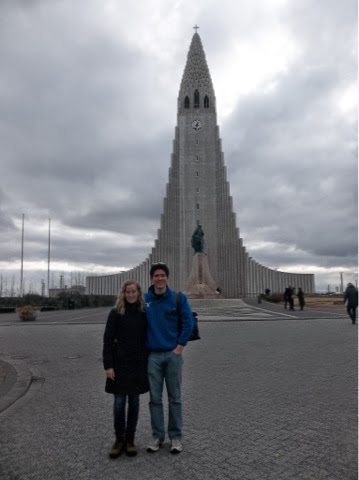Snaeffel is considered an active volcano, thought it has not erupted in centuries. It's currently covered by a glacier, which is believed by locals to "emanate mystic power". In fact, some consider it one of the seven great (mystic) power sources on earth, and some call it the king of the mountains in Iceland. The ancient name for the volcano-glacier power duo means Snowy Mountain, because originally the volcano was only partly covered with snow. Another fun fact: did you know that there was a "little Ice Age" from the Middle Ages to the beginning of the 20th century? Really glad I didn't have to live through that.
Our drive to Snaeffel was beautiful, with much of the same rugged scenery that we has enjoyed while driving out east. Mountains rose and fell to one side, while the coastline ebbed and flowed to the other. After a few hours, we made it to the information center at the base of the mountain. Inside were posters, placards, and all sorts of other informative offerings. A giant map of the peninsula has been edited with small post-it triangles to indicate caves and new paths. Giant signs throughout the exhibit described flora, fauna, and the history of the inhabitants here. I learned that there is only one native species of dog, the Icelandic sheepdog, which was brought over by the original settlers and which has adapted to the local environment and climate. There are few large animals, but there is one species of gray fox, which we were lucky enough to see less than half an hour after visiting the information center. There were also bones of different animals, sheepskin slippers you could test out on the lava, and century-old photos of weather-lined faces. It was probably the most extensive visitor's center we has seen in Iceland, and in such a relatively remote place. It was so thorough that it even ruined the ending of my book for me, but I will forgive it for being such an overachieving place.
At the suggestion of one of the information center employees, we began to take all the side roads and explore the trails, which offered 10-15 minutes of hiking to some interesting rock formation, bird cliff, or light house.
We had wanted to scale the mountain, but there seemed to be no good way to do this... So we made our own trail. We parked on the side of the road and aimed for a point between two peaks, where a flat ridge lay below the two points. The spongy moss was quite nice to walk on, though the underlying volcanic rock made for uneven terrain. There were patches of mud, which Josh feared would turn out to be like quicksand. Lucky for us, we did not get dragged down into it, but it was soft enough that our entire boots were covered in mud and we began to skip along the tops of rocks embedded in the mud for easier passage. I'm not sure exactly what we had intended, but the hike involved quite a lot of elevation and took about an hour each direction. It was probably the most strenuous hiking that we had done, but we both loved it. After so many hours of driving, it felt great to get out and conquer a mountain.
By the time we finished our hike, the first raindrops were beginning to fall and the sky had darkened. We sheltered ourselves in the car and turned toward Reykjavik once more.
Spotted: Cities have crests! The one we have seen most often is, obviously, the one for Reykjavik (shown below), but other towns have them, too.
Spotted #2: The (relatively) major towns here have signs where they start and end, because even the densest areas are sparsely populated and the start and end of towns can be confusing. Josh and I both enjoyed the "end of town" sign, which looks like and anti-town sign.


































